
Homogeneous Catalysis
.pdf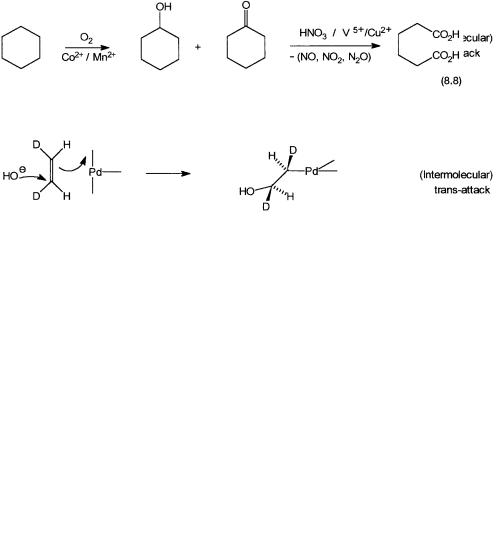
176 OXIDATION
Figure 8.3 Stereochemistry of nucleophilic attack by HO on the coordinated ethylene. Intramolecular and intermolecular reactions should give cis and trans orientations of Pd–C and C–O bonds, respectively. D labeling helps to identify the stereochemistry of addition.
8.3METAL-CATALYZED LIQUID-PHASE AUTOXIDATION
As mentioned earlier, soluble salts of cobalt and manganese catalyze oxidation of cyclohexane by oxygen to cyclohexanol and cyclohexanone. Cyclohexanol and cyclohexanone are oxidized by nitric acid to give adipic acid. The oxidation by nitric acid is carried out in the presence of V5 and Cu2 ions. These reactions are shown by Eq. 8.8. Adipic acid is used in the manufacture of nylon 6,6.
The oxidation of cyclohexanone by nitric acid leads to the generation of nitrogen dioxide, nitric oxide, and nitrous oxide. The first two gases can be recycled for the synthesis of nitric acid. Nitrous oxide, however, is an ozone depleter and cannot be recycled. Indiscriminate nitrous oxide emission from this process is therefore the cause of considerable concern. As shown by 8.9, part of the cyclohexanone can also be converted to the corresponding oxime and then to caprolactam—the monomer for nylon 6. Phthalic acids are one of the monomers for the manufacture of polyesters. As shown by Eq. 8.10, it is made by the oxidation of p-xylene. A general description of polyamides (nylons) and polyesters are given in Section 8.4.
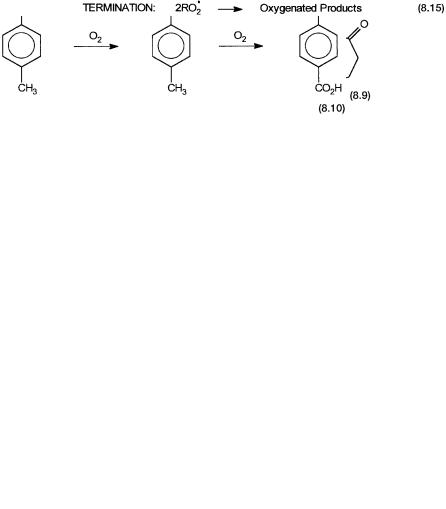
METAL-CATALYZED LIQUID-PHASE AUTOXIDATION |
177 |
8.3.1Mechanism of Autoxidation
Auto-oxidation processes consist of a very large number of simultaneous and consecutive radical reactions. Most of these reactions can be categorized into three basic types, and these are shown by 8.11 to 8.15. Note that for these reactions an organic radical initiator In2 and no metal complex is used. The role of a metal ion in autoxidation processes is that of a catalyst for the initiation steps.
Organic hydroperoxides can be reduced (gain of electron) and oxidized (loss of electron) by metal ions that can easily shuttle between two oxidation states. This is shown by reactions 8.16 and 8.17. It is obvious that the combined effect of these two reactions is the metal-catalyzed decomposition of hydroperoxide to give water, alkoxo, and hydroperoxo radicals. Once these radicals are generated, oxidation can proceed according to the usual propagation and termination steps. In other words, if the metal ions can bring about reactions 8.16 and 8.17, reactions 8.13 to 8.15 would automatically follow. An important addition to the propagation steps under these conditions is shown by 8.19. Note that in In2-initiated autoxidation RO● is not formed in the initiation or propagation steps.
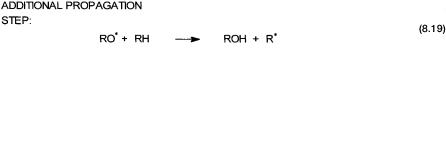
178 OXIDATION
The facility with which metal complexes bring about reactions 8.16 and 8.17 depends on several factors, one of the important ones being the half-cell potential (E o) of the Mn /M(n 1) couple. It should be remembered, however, that most E o values for metal ions have been measured in an aqueous environment. On complexation and in an organic liquid these values are expected to change substantially. The initial hydroperoxide required for metal-catalyzed decomposition, reactions 8.16 and 8.17, is normally present in trace quantities in most hydrocarbons.
With purified hydrocarbons where such trace impurities have been scrupulously removed, a long induction time precedes metal-catalyzed autoxidation. The mechanism of formation of initial RO2H in the absence of a radical chain is not known in any detail, but metal ions do not seem to be involved. The most important point to note in this context is that various types of metal– dioxygen complexes have been isolated and fully characterized. However, such complexes do not seem to play any role in metal ion initiated autoxidation reactions.
With selected organic substrates direct oxidation by metal could be an additional initiation step. This is shown by reaction 8.18. The thermodynamic feasibility of such a reaction depends on the stability of the radical R● as well as the E o value of the M(n 1) /Mn couple. The oxidation potential of Co3 / Co2 is as high as 1.82. As we will see, direct electron transfer from p-xylene to Co3 is an important initiation step for the oxidation of p-xylene.
In a real system many reactions that fit into the general categories represented by 8.13 to 8.15 are possible. This is because the organic intermediates and products themselves may undergo further rearrangement, oxidation, and other reactions. Mechanistic studies for these reactions are therefore invariably based on kinetic models. In these models a set of reactions and associated rate constants are assumed. Through simulation and optimization methods the model is then refined so that best fit between observed and predicted data points are obtained.
The propagation step 8.14 is of special importance. Its rate depends on the R–H bond strength; the weaker the bond, the faster the reaction. This explains why autoxidation of aldehydes is much easier than that of saturated hydrocarbons. The C–H bond energies of –CHO– and –CH2 – groups are approx-
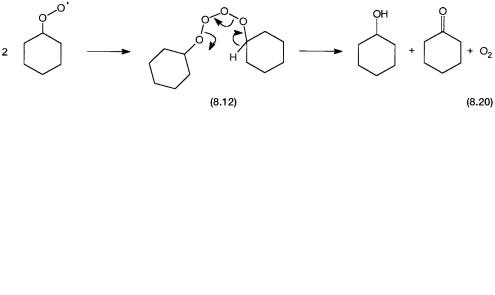
METAL-CATALYZED LIQUID-PHASE AUTOXIDATION |
179 |
imately 85 and 100 kcal mol 1, respectively. This results in a large difference in the relative rates of the respective propagation steps.
8.3.2Special Features of Cyclohexane Oxidation
The first step, oxidation of cyclohexane to cyclohexanol and cyclohexanone, follows the general mechanism outlined by reactions 8.13 to 8.17. Trace quantities of cyclohexyl hydroperoxide 8.9 can initiate the radical chain, where the radicals 8.10 and 8.11 take part in the propagation steps.
One of the termination steps that lead to the simultaneous formation of both cyclohexanol and cyclohexanone deserves attention. The peroxy radical dimerizes to give the intermediate 8.12. The dimer as shown by reaction 8.20, undergoes intramolecular rearrangement to give the products.
The oxidation of cyclohexane is accompanied by the oxidative degradation of the products. In other words, the products themselves undergo metal-initiated radical chain oxidation. For this reason oxidation is normally carried out at low conversions when the selectivity to the desired products is high. The catalysts used are a mixture of hydrocarbon soluble carboxylate salts of Co2 and Mn2 or Cr3 . Due to the better solubility properties, salts of long-chain carboxylic acids such as 2-ethyl hexanoic or naphthenic acids are favored. As already mentioned, the primary role of the metal ions is to act as catalysts for the initiation steps. In other words, the metal ions undergo redox reactions with 8.9 to give 8.10 and 8.11.
The mixture of cyclohexanone and cyclohexanol is oxidized by nitric acid in the presence of V5 and Cu2 ions. This is shown in Fig. 8.4. Since some of the nitric acid is lost as N2 and N2O, the oxidation is “semistoichiometric” in nitric acid. However, the NO and NO2 produced in this oxidation are recycled back.
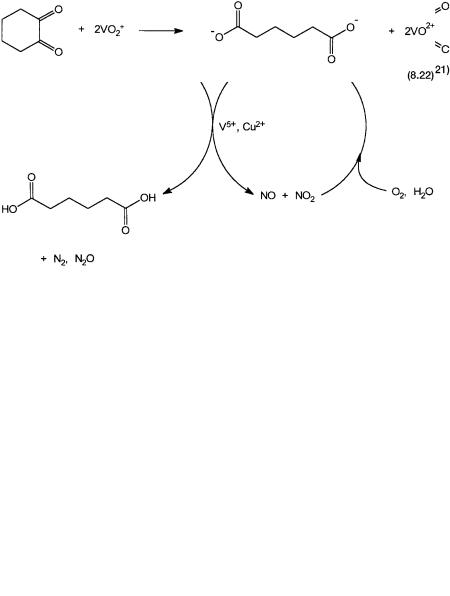
180 OXIDATION
Figure 8.4 Oxidation of cyclohexanol and cyclohexanone by HNO3 to give adipic acid. V5 and Cu2 are in catalytic amounts. NO and NO2 are recycled, but some HNO3 is lost as N2 and N2O (a greenhouse gas).
The roles of vanadium and copper are complex and not fully understood. A large number of intermediates, including the nitroso and the diketo compound as shown by reaction 8.21 are formed. The ion VO2 stoichiometrically oxidizes the diketo compound to adipic acid. This is shown by reaction 8.22.
As shown by reaction 8.23, VO2 species thus generated is converted back to VO2 by nitric acid.
VO2 NO3 → VO2 NO2 |
(8.23) |
The role of copper ion seems to be facilitating further nitration of the nitroso compound. As shown by reaction 8.24, the nitro, nitroso ketone gets converted
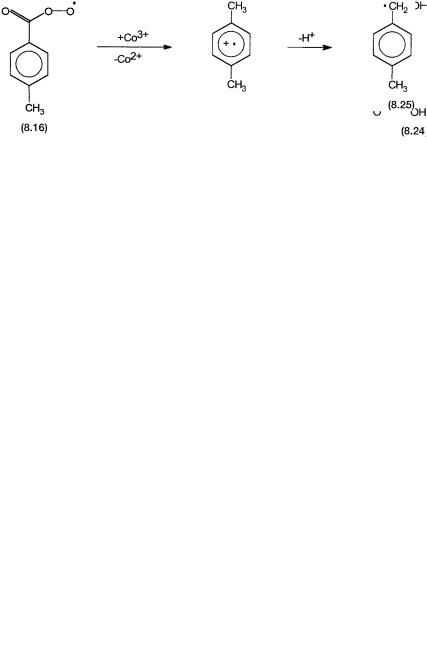
METAL-CATALYZED LIQUID-PHASE AUTOXIDATION |
181 |
to adipic acid. In the absence of copper other degradation pathways leading to unwanted products dominate.
8.3.3Special Features of p-Xylene Oxidation
The most important mechanistic difference between cyclohexane and xylene oxidation is that in the former there is no direct electron transfer from the substrate to the metal ion. In other words, in cyclohexane oxidation the initiation step 8.18 has no role to play. In contrast for all methylbenzene derivatives, xylenes included, this pathway is of importance for chain initiation. As shown by 8.25, formation of the radical species takes place through a radical cation.
The initial products are the p-methyl benzyl alcohol and p-methyl benzaldehyde. Under the reaction conditions these are further oxidized, first to p- toluic acid, and ultimately to terephthalic acid. The alkoxy and peroxy radicals that take part in the oxidation of p-xylene to p-toluic acid are shown by 8.13 to 8.16.

182 OXIDATION
Commercially two main processes, that of Mid-century/Amoco and Dynamit Nobel/Hercules, are operated. In the former acetic acid is used as a solvent. Mixtures of cobalt and manganese bromide and acetate salts are used to catalyze the initiation step. The reaction conditions, a temperature of about 220 C and a pressure of 15 atm, are relatively severe. Under these conditions bromine and •CH2CO2H radicals are formed. These radicals can effect new initiation steps. In the overall process, though toluic acid is an intermediate, it is never isolated. The final isolated product is terephthalic acid (see reaction 8.10).
In the Dynamit Nobel/Hercules process no solvent is used. A mixture of cobalt and manganese ethyl hexanoate is used as the catalyst under relatively mild conditions, about 160 C and 7 atm pressure. The product under these conditions is toluic acid, which is isolated and then converted into the methyl ester. The important point to note is that under the operating conditions toluic acid does not undergo any further oxidation. This means that toluic acid is more difficult to oxidize than p-xylene. The methyl ester of toluic acid is then co-oxidized with p-xylene. The product obtained is monomethyl terephthalate, which by reaction with methanol is then converted to dimethyl terephthalate.
The advantage of the Amoco process is that high-purity terephthalic acid is produced in one step. The solubility of terephthalic acid in acetic acid is low; its separation with high purity by crystallization is therefore relatively easy. However, the corrosive nature of the acids and the relatively drastic conditions make it necessary to use special material of construction for the reactors.
8.4 POLYMERS (POLYESTERS AND POLYAMIDES) FROM AUTOXIDATION PRODUCTS
Poly(ethylene terephthalate) in short PET is a polyester. It is mainly used in the garment industry with or without natural cotton and has trade names such as Terylene , Dacron , etc. As the name indicates, it is a polymer between terephthalic acid (PT) and ethylene glycol. Both terephthalic acid and dimethyl terephthalate (DMT) can be used to make the polymer. A majority of the modern plants tend to use PT as the starting material because of the availability of high-purity PT on a large scale. Both PT and DMT are first converted to bis(hydroxy ethyl) terephthalate 8.17 (see reaction 8.26). For PT this is effected by a straightforward esterification reaction. For DMT a transesterification reaction catalyzed by zinc and manganese acetate is used.
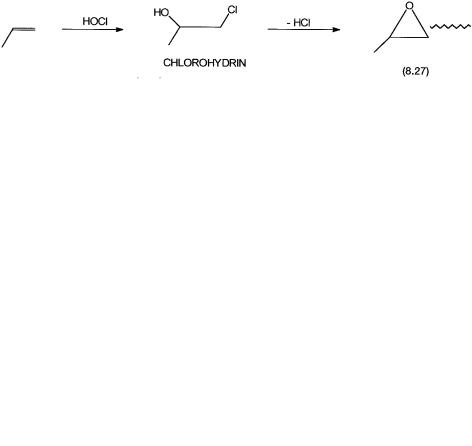
EPOXIDATION OF PROPYLENE |
183 |
The polycondensation reaction to give the desired polymer, 8.18, is carried out at high temperatures (>260 C) in the presence of Sb2O3 and Ti-alkoxide catalysts. The roles of the catalysts at the molecular level are not known in any detail. As shown by reaction 8.26, in the polycondensation reaction one molecule of ethylene glycol is also generated for each molecule of the monomer.
Nylon 6,6 and nylon 6 are polyamides. These polymers are used in carpets, in hosiery, and in certain cases as engineering plastics. Nylon 6,6 8.19, is the condensation product between adipic acid and 1,6-diamino hexane. Nylon 6 8.20 is made from caprolactam by ring-opening polymerization.
8.5EPOXIDATION OF PROPYLENE
Propylene oxide is an important commmodity chemical. It is used in the manufacture of propylene glycol, glycerine, polyethers, etc. Ethylene oxide can be made selectively by the direct oxidation of ethylene over a heterogeneous catalyst, but propylene to propylene oxide by selective heterogeneous catalytic oxidation has so far not been achieved. As shown by 8.27, traditionally propylene oxide has been made by converting propylene to the chlorohydrin and then dehydrochlorinating it. The hydrochloric acid generated in the last step is neutralized with lime.
A homogeneous catalytic process, developed by Oxirane, uses a molybdenum catalyst that epoxidizes propylene by transferring an oxygen atom from tertiary butyl hydroperoxide. This is shown by 8.28. The hydroperoxide is obtained by the auto-oxidation of isobutane. The co-product of propylene oxide, t-butanol, finds use as an antiknock gasoline additive. It is also used in the synthesis of methyl t-butyl ether, another important gasoline additive. The over-
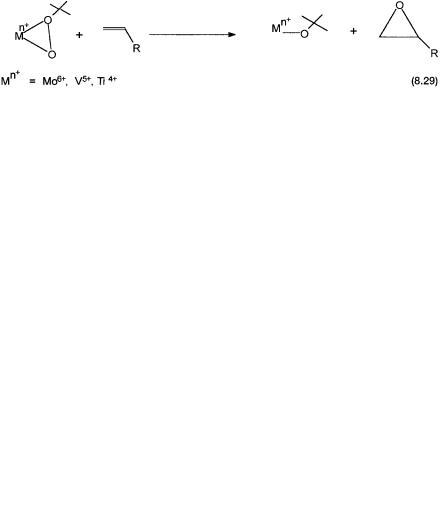
184 OXIDATION
all superiority of the homogeneous catalytic process over the chlorohydrin route lies in better economics, as well as avoidance of generation of large quantities of chloride salt as waste (see Problem 5 in Chapter 1).
8.5.1Catalytic Cycle and the Mechanism of Propylene Epoxidation
The proposed catalytic cycle is shown in Fig. 8.5. A variety of molybdenum compounds may be used as the precatalyst, and Mo(CO)6 is shown as a representative one. Under the strong oxidizing conditions the precatalyst is oxidized to 8.21, a species that has molybdenum in a 6 oxidation state and a cis-MoO22 unit. The other ligands are two solvent molecules and hydroxo and/ or alkoxo groups. In the absence of a solvent, positions occupied by S are occupied by t-butanol, the decomposition product of t-butyl hydroperoxide. The important points to note are that molybdenum is in its highest oxidation state (6 ), and there are weakly bound solvent molecules.
On reaction with ButOOH, 8.21 eliminates ButOH and is converted to 8.22, which has a chelating t-butyl hydroperoxo ligand. Two mechanistic pathways from 8.22 have been proposed. In Path A propylene undergoes electrophilic attack by the distal oxygen atom, the oxygen atom away from the t-butyl group. As shown by reaction 8.29, Ti4 , V5 , and Mo6 are known to be capable of effecting this type of oxygen atom transfer reaction. Note that coordination by propylene is not invoked if 8.23 is the proposed intermediate. The O atom transfer leads to 8.24, which has a weakly bound propylene oxide molecule. A solvent molecule displaces the coordinated propylene oxide. This regenerates 8.21, and the catalytic cycle is completed.
In the other mechanistic postulate, coordination by the alkene as in 8.25 followed by insertion into the Mo–O bond to give a metallocyclic species 8.26 is proposed. As shown by Path B, this metallocyclic species is then converted to 8.24 through an intramolecular rearrangement.
Species like 8.22 with V5 as the metal ion has been isolated and characterized by X-ray studies (see Section 2.5.3). The reactivity of such complexes with alkenes has considerable similarities to the molybdenum-catalyzed epoxidation reaction. Kinetic studies with these model complexes indicate coordi-
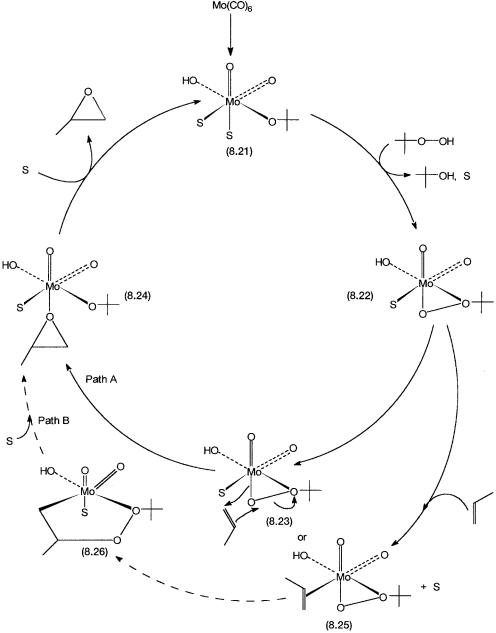
EPOXIDATION OF PROPYLENE |
185 |
Figure 8.5 Catalytic cycle for the molybdenum-catalyzed oxidation of propylene by t-butyl hydroperoxide. Paths A and B are the two proposed alternative mechanisms for oxygen atom transfer. No evidence has been found for 8.26.
